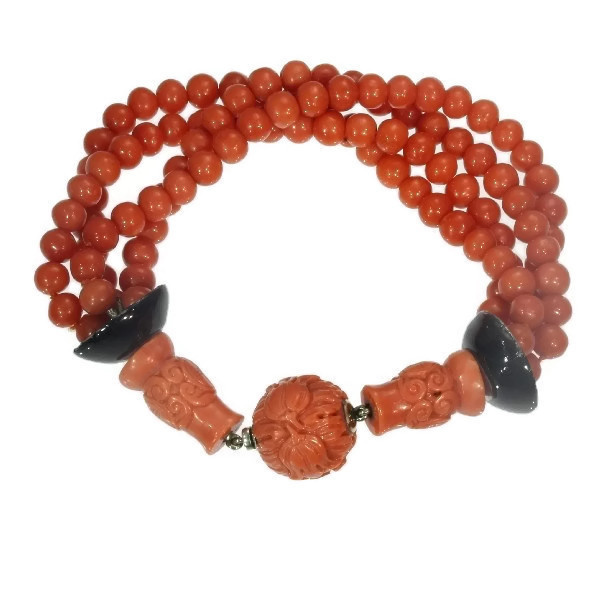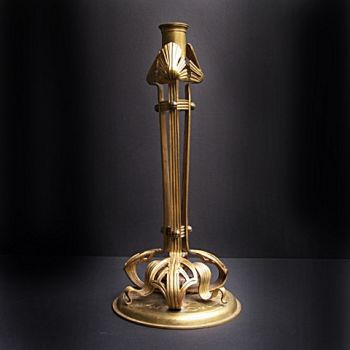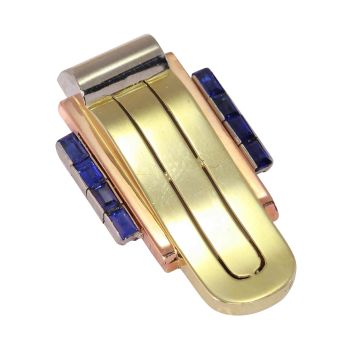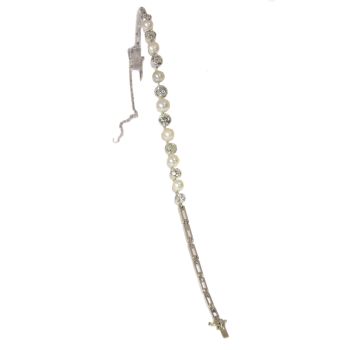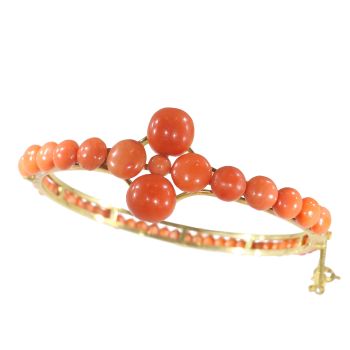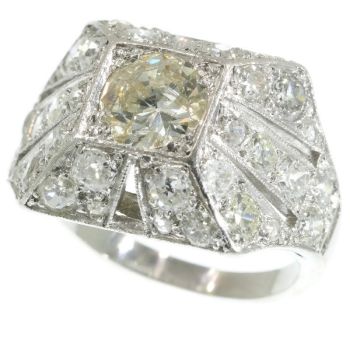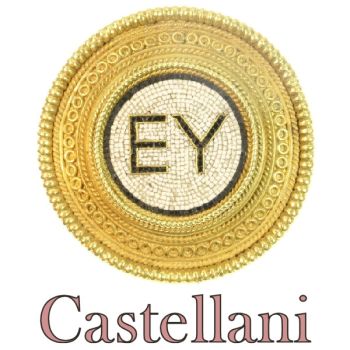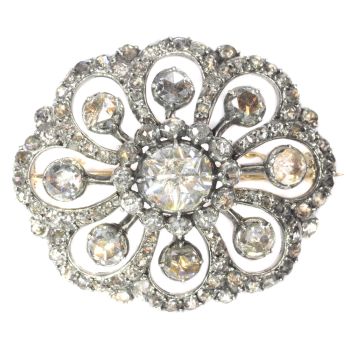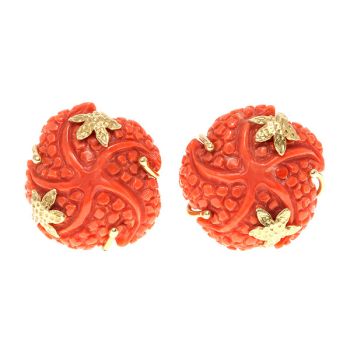Art Deco enameled coral beaded bracelet, 4 strands 1920
Unknown artist
Yellow GoldCoralGoldRed coral
€ 8.500
Adin Fine Antique Jewellery
- About the artworkArt Deco enameled coral beaded bracelet, 4 strands.
This Art Deco bracelet ascends from customary antique jewellery to the level of applied arts due to its rare combination in craftsmanship of goldsmithed 18K yellow gold, of delicately engraved coral beads and of a black enamelled finish. Four coralstrands guide you to a Japanese garden with a central round coral bead with tulip engravings, which disguise the jewel's closure. Two engraved columns followed by black enamelled convex portals guard this gem. Being a strong representative of Japonism in the 1920's, this bracelet is eagerly waiting to serve its next Geisha.
Antique jewelry object group: flexible bracelets/bangles
Country of origin: Although it does not carry any legible control marks we believe this to be of French or Belgian origin.
Style: Art Deco
(more info on styles)
Style specifics: Abstract motives and geometrical forms are quite typical for the Art Deco period.
Period: ca. 1920
(events and facts in 1920)
Source of inspiration: Japan
Theme: Japanese style engravings in the coral
Material: 18K white gold
(more info on precious metals)
Technique: Enamelling is an old and widely-adopted technology. The ancient Egyptians applied enamels to pottery and stone objects. The ancient Greeks, Celts, Russians, and Chinese also used enameling processes on metal objects. Enamel is the colorful result of fusing powdered glass to a substrate by firing, usually between 750 and 850 degrees Celsius. The powder melts and flows and hardens to a smooth, durable vitreous coating on metal, glass or ceramic. According to some sources, the word enamel comes from the High German word smelzan (to smelt) via the Old French esmail. Used as a noun, "an enamel" is a usually smalldecorative object, coated with enamel coating, such as a champlevé or a cloisonné (different techniques).
Extra information: Japonism, or Japonisme, the original French term, which is also used in English, is a term for the influence of the arts of Japan on those of theWest. The word was first used by Jules Claretie in his book L'Art Francais en 1872 published in that year. Works arising from the direct transfer of principles of Japanese art on Western, especially by French artists, are called japonesque.
Precious stones: coral(more info on precious stones):
- Four coral bead strands with 104 corals in total, diameter approx. 6 mm
- Two engraved coral ornaments measuring approx. 17.7 mm by 10.5 mm
- One round shaped engraved coral (the clasp) with a diameter of approx. 16.6 mm
Hallmarks: No trace.
(more info on hallmarks)
Condition: good condition (one of the white gold dishes that are black enameled has some chips off at the edge)
(more info on our condition scale)
Dimensions: length 20.50 cm (8.07 inch)
Weight: 50.00 gram (32.15 dwt)
Reference Nº: 10015-4360
See also our:
bracelets, art deco jewelry, jewelry with enamel, jewelry with coral, latest acquisitions,
antique jewelry, estate jewelry, vintage jewelry or modern jewelry
Jewelry with birthstones (or month stones) for:
January - February - March - April - May - June - July
August - September - October - November or December.
Additional information:
jewelry glossary - wall of fame - visit us in Antwerp - subscribe to our mailinglist.
What is antique jewelry? - What is estate jewelry? - What is vintage jewelry? - About the artist
It might happen that an artist or maker is unknown.
Some works are not to be determined by whom it is made or it is made by (a group of) craftsmen. Examples are statues from the Ancient Time, furniture, mirroirs, or signatures that are not clear or readible but as well some works are not signed at all.
As well you can find the following description:
•“Attributed to ….” In their opinion probably a work by the artist, at least in part
•“Studio of ….” or “Workshop of” In their opinion a work executed in the studio or workshop of the artist, possibly under his supervision
•“Circle of ….” In their opinion a work of the period of the artist showing his influence, closely associated with the artist but not necessarily his pupil
•“Style of ….” or “Follower of ….” In their opinion a work executed in the artist’s style but not necessarily by a pupil; may be contemporary or nearly contemporary
•“Manner of ….” In their opinion a work in the style of the artist but of a later date
•“After ….” In their opinion a copy (of any date) of a work of the artist
•“Signed…”, “Dated….” or “Inscribed” In their opinion the work has been signed/dated/inscribed by the artist. The addition of a question mark indicates an element of doubt
•"With signature ….”, “With date ….”, “With inscription….” or “Bears signature/date/inscription” in their opinion the signature/ date/ inscription has been added by someone other than the artist
Are you interested in buying this artwork?
Artwork details
Related artworks
Unknown artist
The Stamford Raffles Secretaires.1800 - 1813
Price on requestZebregs & Röell - Fine Art - Antiques
1 - 4 / 12Unknown artist
Japanese art deco lacquervase with Scarab beetle motif1920 - 1950
Price on requestDille Art
1 - 4 / 24Unknown artist
18th Century Diamond Bracelet with 2000-year-old Intaglios1790
€ 23.000Adin Fine Antique Jewellery
 Curated by
Curated byDanny Bree
1 - 4 / 24Unknown artist
A rare filigrana a retortoli goblet1550 - 1600
Price on requestPeter Korf de Gidts - Antiquairs
1 - 4 / 24- 1 - 4 / 24
- 1 - 4 / 12







